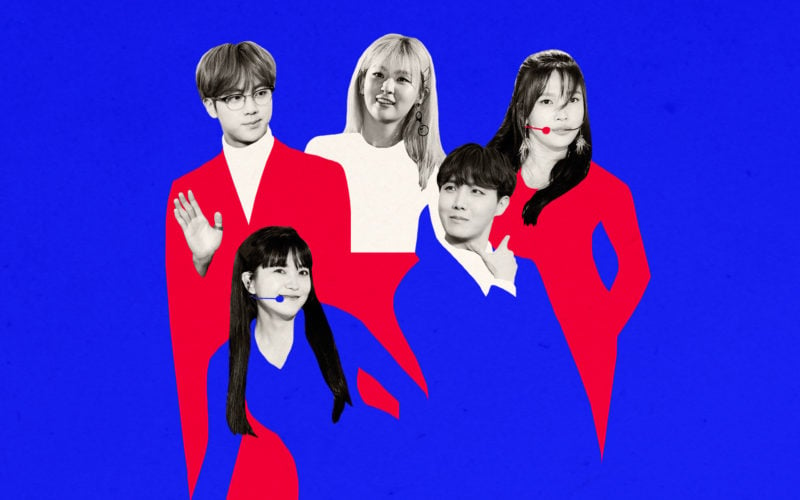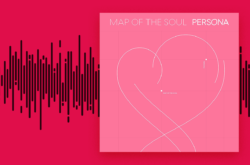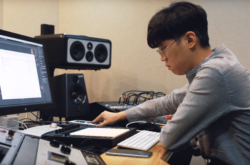Photo illustration: Celina Pereira
There’s no such thing as K-pop – it’s just pop music created by Korean people.
This is the first installment of a mini-series exploring K-pop’s history, production, and culture. It’s an expansive topic, and we’re committed to doing our best to discuss and share any thoughts from a place of respect and deference to a rich culture.
Reader, it is both simple and complicated to define what K-pop is. On one hand, it’s simply what the title of this series states: it’s pop music created by Korean people. But for those who aren’t die-hard fans or even casual listeners, the mind wanders to the stereotypes: electronic dance music, bubblegum pop, and formulaically choreographed numbers.
Western media often enjoys taking implicit jabs in describing the genre. But the reality is that ‘K-pop’ is made up of elements that we’re more than familiar with – the Wikipedia page lists the influences of K-pop as “experimental, rock, jazz, gospel, hip hop, R&B, reggae, electronic dance, folk, country, classical, and traditional Korean music.” It just happens to be created by people who we may not be as familiar with.
Why I’m writing this
I grew up in Nashville, TN – a.k.a. Music City, U.S.A. I was exposed to every type of popular genre and style of music under the sun, and rarely experienced a moment when I wasn’t glued to the radio listening to the dulcet tones of Ryan Seacrest announcing the American Top 40 on 107.5 The River. Growing up Korean in Nashville meant that most of the musical idols I admired (and belted loudly in the car to) were people who looked nothing like me. It was also an invitation for my peers to ask if I listened to this thing called “K-pop,” and be met with disappointment when I ended the conversation with “I don’t.”
My introduction to K-pop started as a birthday gift from a distant relative: it was BoA’s first CD. I added it to my rotation of Backstreet Boys, Avril Lavigne, and Destiny’s Child. To my pop-hungry ears, it felt natural listening to BoA belt in between Avril and Beyoncé, countered with Justin Timberlake.
BoA was the first artist I listened to who looked like me. The music was upbeat, had a positive message about female empowerment, and impressive dance moves that followed the beat. But my most pointed memory about BoA was playing her CD at a sleepover and watching my friends groove to the intro. But then, when BoA started her verse in Korean, they boxed their ears and turned up their nose, telling me that I played “bad music” and to change the song. I felt so ashamed that I threw the CD into the back of my closet.
When it came to the music culture wars, it felt like I couldn’t win. It started with genre, where people would “like all music except for country.” But growing up in Nashville, I had a high respect for the genre and appreciation for the music. Whether it’s country or K-pop, to this day I really don’t understand why having a musical taste that differs from someone else is such a personal affront.
I was to be and not to be a K-pop fan. The expectation was simple: a Korean person should like K-pop music. But if I was too much of a fan, I was met with disdain that I could like such a style, or that it wasn’t ‘real’ music. I was taught to be ashamed of a style simply because the only familiarity my peers had was a stereotype.
Cliff notes of music culture’s evolution
But, from the ’90s to the 2000s to the 2010s, the introduction of new technologies and genre blending / breaking gradually became more of a norm to music culture, both domestically and internationally.
On the technology front, how we consume music changed dramatically with the evolution of the internet: in just two decades, iTunes launched, LimeWire rose and fell, and Napster took off only to be bankrupted by the major labels. Radio went from being the primary source of consumption to an afterthought. Streaming appeared in an effort to fight piracy from digital music stores, only to compound the problem.
In terms of genre, there was a long-delayed lowering of barriers. Electronic music came over in a tidal wave, entering the mainstream and changing music production from requiring a full band and studio time to just a laptop. Looking at the various shifts across just the last three decades, we can see the same transformations occurred in a condensed timeframe for K-pop.
Three aspects to highlight about K-pop
The culture surrounding K-pop has a number of key characteristics that make it unique. Below are a few that are particularly notable.
- The country throws its weight behind it. While other countries notoriously slash funding to the arts and music programs, the Korean government and its conglomerates pour money into the industry to create training programs, stocks, marketing campaigns, and broadcasts of variety shows that feature artists.
- There are a lot of K-pop groups. With a quick google search, one will be bombarded with countless different groups and endless YouTube playlists of music videos marketing them. It’s an oversaturated market, but having so many groups is what pushes both conformity and innovation. Groups can take the risk of being ‘different’ and hit it big, or quickly disappear into internet obscurity. The constant production of music, shooting of videos, etc. invites small but regular experimentation, which creates an environment of many calculated bets in a condensed period of time.
- Dance and choreography are a key part of the music. The formation and movements of each member are critical, and highlight the role of the individual and how they add to the group’s identity as a whole. In addition to that, the aesthetics are a key component in creating the larger experience of a musical performance: the outfits and makeup of the entire group tell a cohesive story. An album is always simultaneously a visual album.
With these aspects in mind, let’s now look briefly at the musical trends experienced in the West. America has touted itself as the juggernaut of culture – the melting pot, the global soft power of music. America is where many artists around the world dream of their music taking off. With the goals of winning GRAMMYs and charting on the U.S. Billboard being popular internationally, it’s only natural that one creative drive is to make music that appeals to the ‘American taste.’ With regards to that fickle taste, let’s look at some highlights from the last decade:
- In 2012, PSY’s “Gangnam Style” went viral and become the first video on YouTube to surpass one billion views.
- In 2016, “Uptown Funk” brought disco back to the radio, paired with a fun music video featuring the inimitable Bruno Mars and his dance moves.
- In 2017, “Despacito” was the song of the summer, becoming one of only eight non-English songs to have topped the U.S. Billboard charts.
- More recently, viral dance challenges have become a norm in engaging audiences with a song. “Old Town Road” and its challenge became a TikTok sensation, pairing dance moves with an extremely catchy beat and skyrocketing Lil Nas X into pop stardom.
With the virality and omnipotence of TikTok, pop music now needs to be ‘TikTok-able.’ In a sense, it’s what K-pop has required of its songs from the get-go – are you considering choreography as you write, or after the record is finished? Is the dance enjoyable to watch, learn, record, and repeat? Does it fit into a one-minute video while still capturing the larger essence of the song?
The collide of K-pop and the West in the last five years
K-pop powerhouse BTS debuted in 2013 with a hip hop sound mixed with rock, but have evolved their sound with every album over the last seven years, increasingly working with more Western producers over time. Steve Aoki produced a remix of their hip hop / electronic hit “Mic Drop,” which later had an additional release featuring Desiigner. Nicki Minaj dropped a verse on their stadium anthem, “IDOL.” The Chainsmokers produced “Best of Me” on Love Yourself 結 ‘Answer.‘ Ed Sheeran, a champion songwriter, co-wrote on the album Map of the Soul: Persona, and the single “Boy With Luv” featured pop vocalist Halsey.
Meanwhile, BLACKPINK hit the scene with “Whistle” in 2016 as part of their debut, and quickly amassed a following with their electric hooks and heavy bass production. They worked with Dua Lipa on “Kiss and Make Up,” which was produced by the dancehall duo Banx & Ranx. They were featured on Lady Gaga’s latest album, and released their debut full-length The Album earlier this month.
K-pop is inevitably entering the mainstream of American music culture, but it’s throwing the industry giants for a loop. The Western music industry has long relied on a tried and true formula: take, oversimplify, and mass produce creative culture. It’s a rinse-and-repeat equation applied by antiquated industries who managed to survive by force. But, K-pop will be difficult because it does what American music culture has aspired to do itself: it takes different elements from various genres and combines them into a new style that’s one of its own.
So does K-pop = pop?
If the surface-level qualifications of pop music are:
- Does it chart?
- Does it win awards?
- Does it have a dedicated audience (as well as dedicated haters)?
- Does it celebrate a culture?
- Is the music loved internationally?
…Then K-pop seems to check all of the boxes. K-pop in many ways represents what pop has been moving towards for quite some time in the West: genre-blending sounds, visual albums, tight choreography, and danceability to share that aspect of the music with the audience (think TikTok).
And with the more recent transparency around intense rehearsals, auditions, trainings, and try-outs, K-pop admits that it’s not a perfect system. However, in ways it highlights that creativity is hard work and challenges the myth that the arts are just effortless talent that manifests itself in particular individuals. The constant rehearsals, clean lines, and natural movements created by constant repetition reveal discipline and diligence. It takes away the illusion that ‘making it’ is solely about natural-born talent or luck.
The global appeal of K-pop
The global appeal of K-pop comes from its blend of many different styles, visuals, and influences from artists who refuse to be boxed in. But it’s not just about the sound or aesthetics – many K-pop artists including the likes of BTS have rallied around the message of embracing self love, which is a journey that often spans a lifetime. And in times like these, who doesn’t love a message about self love?
With K-pop at the forefront, the last frontier of ‘global music,’ i.e. Asia, has come stateside, and its appeal and international audience are here to stay. Monolithic music industries can no longer deny that global music culture — beyond just Asian artists but comprised of all international artists — is in the power of its listeners armed with the internet.
At the very least, that shift in power is coming. The reality? It’s already here.
Join the Splice Discord to engage with a community of other music creators, participate in producer-led beat battles, and hear exclusive interviews:
October 29, 2020



